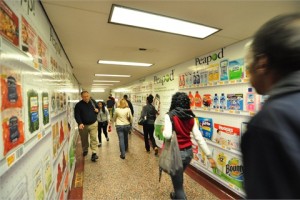During this day and age, there are two main themes behind our technological advances as a human race: innovation and convenience. Almost everything is available via the Internet and accessible with our computers or smart phones. We can shop for clothes, order dinner, pay our bills, and do a lot more using our handheld devices. The newest addition to our already impressive lineup is a virtual supermarket. I know what you’re wondering, does this mean I will have to eat virtual food? The answer is no, virtual supermarkets have the same end goal as ordinary grocery stores: you get your produce in your fridge as expected.
Virtual supermarkets started in Japan and South Korea by Tesco Homeplus, a British grocery company. They are strategically located in subway stations alongside the walls and are set up as regular grocery stores, but instead of actual products, there are pictures of the items with a QR code beneath them. Users scan the QR codes with their smart phones and add the items to a virtual shopping cart. Once all of the products are in the cart, the shopper places the order and is charged through their credit card. The groceries then arrive at the person’s doorstep the next day. Virtual supermarkets eliminate the hassle of actually visiting a grocery store, physically carrying the items, and they also save a lot of time for shoppers.
The U.S. has caught on to the craze by introducing virtual supermarkets in Chicago, Boston, New York, and other major metropolitan areas. Peapod, a U.S. grocery company, has taken the initiative by setting up virtual supermarkets in subway stations just like Japan and South Korea. So far, there has been positive feedback from the younger generation, but older people prefer to physically visit the stores. This shows that we are truly in an age of innovation and convenience, or that we have become extremely lazy.
An advantage that virtual supermarkets have from an operations management perspective is the management of inventory. By not having the inventory physically present, the products won’t sit on the shelves and companies can place orders for certain items based on the online demand, eliminating backlog.
I believe that having virtual supermarkets is a step forward in the right direction, but this step lacks some benefits that are present when physically being in a store. When I was younger, I used to always accompany my mom to the grocery store and she would tell me how to pick out the ripe fruits, or how to tell similar vegetables apart. She knew exactly what she was getting by touching and feeling the products. Another missing component to virtual grocery shopping is taste-testing the food. Many times we are not certain about what to buy and by trying a sample, we decide whether or not to purchase the product. That is one advantage that places like Costco will have over virtual supermarkets.
Virtual supermarkets define innovation and convenience, but are not for everyone. Would you ever consider using one, and if so, do you see virtual supermarkets replacing physical grocery stores in the future?
Sources:
http://www.apartmenttherapy.com/virtual-grocery-shopping-and-v-158354
http://www.huffingtonpost.com/2012/10/01/peapod-virtual-grocery-st_n_1929756.html
http://www.zdnet.com/virtual-supermarket-shopping-with-a-smartphone-4010022941/
